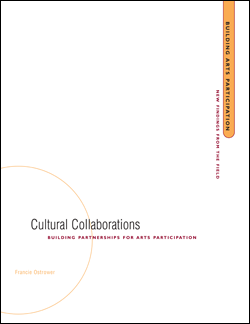Cultural Collaborations
Building Partnerships for Art Participation
January 2003, 46 pages. The Urban Institute, 2100 M Street, NW, Washington DC 20037, 202-833-7200, 202-429-0687 (fax), www.urban.org/publications/310616.html.
Download:
![]() Cultural Collaborations (244Kb)
Cultural Collaborations (244Kb)
Cultural Collaborations investigates how cultural organizations use partnerships to increase audience participation. Although the organizations studied for this report represent only a small cross-section of cultural organizations, the results can assist other organizations by showing both the successful and less-than-successful elements of the partnerships examined.
The selected partnerships had participated in a five-year initiative funded by the Wallace-Reader's Digest Funds. Funding was provided to ten community foundations that then funded local cultural groups, and aimed to build and strengthen arts participation in those communities. The Urban Institute investigated how nineteen of the partnerships fostered community participation.
Partnership, as defined in this study, means a coordinated collaboration between two or more parties to achieve a common goal (p. 9). A variety of partnerships resulted from the initiative, and while the sample is too small to derive definitive insights, the specific examples do offer insights into the successes, challenges, and difficulties encountered by the participating groups.
The results of the study are presented honestly and in a forthright manner. If a partnership encountered problems or did not work, this information is included. The participating organizations are presented blindly, encouraging an objective assessment. They are not presented with enough specifics to enable identification, but are described according to organization size, usual audience served, and cultural field.
Most partnerships entered the initiative with similar goals about audience and program development. Many groups were able to expand their programming and engage new audiences, at least for the duration of the grant period. Although they did not view this expansion as permanent, they did benefit from sharing resources with their partner. The organizational networks and relationships created during the partnership were an unanticipated benefit of the partnership, and often less formal resource sharing continued after the end of the grant-funded pairing.
Since most of the “official” partnerships did not continue beyond the grant period, the study examined why the partnerships were not sustained, with reasons ranging from a lack of financial support, to logistical costs and conflict with an organization's mission, as well as a lack of purpose other than the one provided by the initial grant.
Overall, most organizations felt they benefited from the partnership, the most cited benefit being expanding the organizations' connections and resources beyond their status quo. The study stressed that partnerships are just one of the tools available to cultural organizations, and if used incorrectly, will not work properly. The lessons learned from these partnerships can be applied to other organizations considering partnerships and can assist them in creating an efficient and beneficial one.
Cultural Collaborations, is an interesting view into the successes and challenges resulting from partnerships formed by a few organizations. The analysis provides helpful insights that all organizations and funders should keep in mind when considering creating a partnership.

